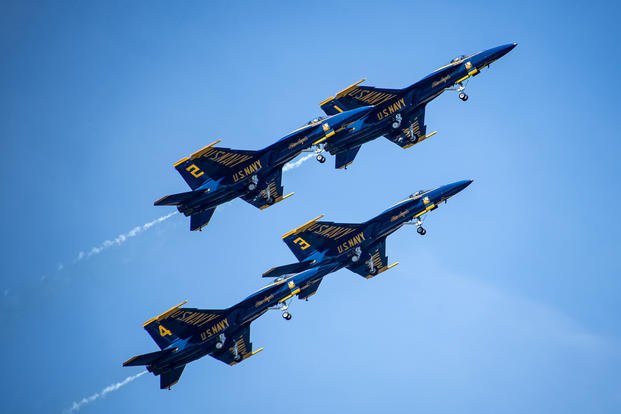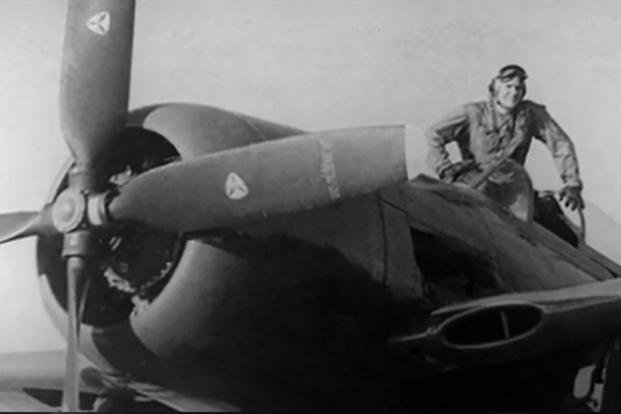As Capt. Roy “Butch” Voris trained with other naval aviators in preparation for the public debut of the Blue Angels, the nascent aerobatic team put on a demonstration for a senior member of Adm. Chester Nimitz’s staff. Wanting to see firsthand how their training was going, he came away thoroughly impressed and shaking his head.
“‘You crazy sons of bitches are going to kill yourselves,'” Voris recalled the senior leader saying in a 2003 interview with the Museum of Flight near Seattle, “but he said, ‘I like it. I want the admiral to see it.'”
By now, almost eight decades after the Blue Angels’ first flight at Naval Air Station Jacksonville in Florida on June 15, 1946, about 500 million people have witnessed firsthand the U.S. military’s most enduring and popular flight demonstration team. Sometimes approaching 700 mph, the aviators weave through the air in extremely tight formations, their fighter jets working in unison merely feet apart, to the applause and amazement of their earthbound onlookers.
That level of precision requires hours of intense training, and no one knew that more than Voris, whom Nimitz handpicked as the Blue Angels’ first commander. Voris, who died in 2005 at the age of 85, arrived at this history-making assignment with impeccable credentials after thriving as an ace fighter pilot during World War II.
“I got shot down once,” Voris once recalled. “Those things happen, but I shot down eight of them, so I call it a net of seven.”
A lifelong lover of aviation, Voris hung model airplanes from his bedroom ceiling, devoured stories about the exploits of famed military pilots such as Eddie Rickenbacker and sometimes rode his bike several miles to an airport just to watch airplanes land. While working in a mortuary in San Francisco in early 1941, Voris noticed a Navy recruiting poster and enlisted because he wanted to learn how to fly.
Months into the Naval Aviation Cadet Program in Corpus Christi, Texas, Voris and other cadets were leaving a movie theater on Dec. 7, 1941, when they learned of the Japanese’s surprise attack at Pearl Harbor, ushering the United States into World War II.
“Everybody wanted to get their hands on a war machine,” Voris recalled. “We started flying out over the water to see if there were Japanese submarines in the Gulf [of Mexico]. That was kind of fruitless, but we had to do something.”
Commissioned as an ensign in February 1942, Voris flew F4F Wildcats and F6F Hellcats off two aircraft carriers, the USS Enterprise and USS Hornet, and saw combat in the battles of Guadalcanal and Tarawa during the war.
He was also present during the Battle of the Philippine Sea on June 19-20, 1944, when Allied pilots, realizing they likely would run out of fuel before they could return safely, ignored that possibility and departed near dusk in pursuit of the Japanese fleet. During what became known as the “Mission Beyond Darkness,” Voris flew by dead reckoning under the cover of night. After destroying a Japanese Zero fighter, he returned to his carrier. When Voris touched down, only 10 gallons of gas remained in his fuel tank.
“It was almost mob hysteria,” Voris told the Museum of Flight. “I don’t even like to talk about it — people diving at the ship, trying to get down, trying to make landings on cruisers and destroyers. We spent the next day … picking pilots up out of the water, so we did pretty well, rescuing a lot of those crews.”

When Voris was tasked with forming the Blue Angels, he sought out pilots like him, those who always pushed themselves a little further, “stuck it out 10% more,” he told author Robert K. Wilcox for the 2004 book “First Blue: The Story of World War II Ace Butch Voris and the Creation of the Blue Angels.”
Voris was also heavily involved in choosing the type of aircraft they would fly — the Blue Angels started off flying the F6F-5 Hellcat before transitioning to the F8F Bearcat shortly thereafter — as well as the personnel who would help maintain those aircraft. He even insisted on the planes being painted blue and gold, the Navy’s official colors.
The Blue Angels — named after a New York City nightclub — endured intense training, and their mission was top secret. They even practiced maneuvers in the Everglades in South Florida so if they crashed, only the alligators would know.
“He was very technical, very smart about aeronautics,” Voris’ son-in-law, Hank Nothhaft, told The Washington Post. “Talking to him, you’d think he was an engineer. In fact, that’s probably how he survived some of the mishaps.”
No mishap was more perilous than during a show in 1952. During Voris’ second stint as the Blue Angels’ leader — the team briefly disbanded at the start of the Korean War — he was involved in a midair collision. One pilot was killed, and Voris landed with a heavily compromised jet, its controls barely working and its tail almost ripped off.
The Blue Angels returned to the air two weeks later.
Voris left the Blue Angels in December 1952 but remained in the Navy until retiring from the military in 1963. With three Distinguished Flying Crosses, 11 Air Medals, three Presidential Unit Citations and a Purple Heart, he left the service as a highly decorated pilot.
For the rest of his life, the Blue Angel pilots who came after him viewed Voris with reverence — and with good reason.
“I can’t think of a bad day that I’ve had, what you’d really call a bad day,” Voris said in the Museum of Flight interview. “Anything that’s bad, it’s an opportunity to fix it and be better.”
For upcoming shows involving the Blue Angels, including their 2025 schedule, please go to their website.
Want to Know More About the Military?
Be sure to get the latest news about the U.S. military, as well as critical info about how to join and all the benefits of service. Subscribe to Military.com and receive customized updates delivered straight to your inbox.
Story Continues
Read the full article here

